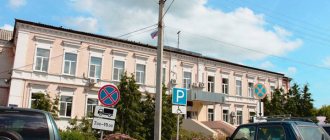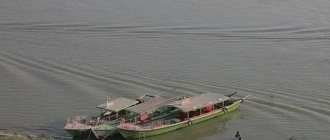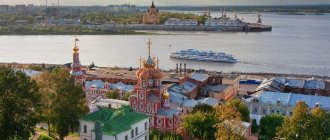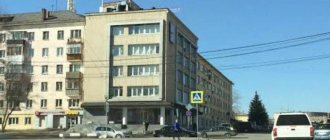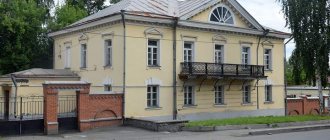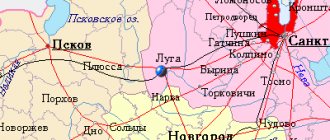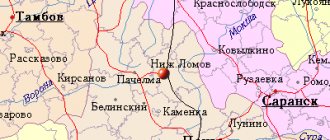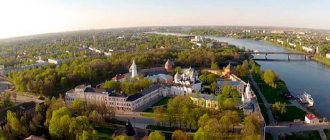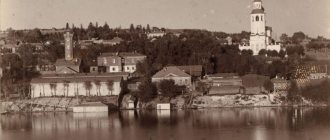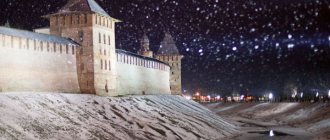Founded: 1221
Nizhny Novgorod celebrates City Day on
the 3rd Saturday of August
.
In 2022,
this date is
August 20
.
Chkalov Stairs with the monument of the same name at the top
Nizhny Novgorod
- a Russian city, the center of the Volga Federal District, located along the banks of the Oka River, at its confluence with the Volga.
The city was founded by Prince Yuri Vsevolodovich in 1221
to protect Russian borders from Mordovians and Tatars.
In 1341, the city became the capital of the Suzdal-Nizhny Novgorod principality. In the 15th century, when the principality became part of the Moscow state, Nizhny Novgorod did not lose its importance as a guard fortress. Often, campaigns against the Kazan Khanate began from here. And only when Kazan was taken, the fortress of Nizhny Novgorod lost its relevance.
Nizhny Novgorod residents Kuzma Minin and Prince Dmitry Pozharsky led the militia in 1611 and in October 1612 liberated Moscow from Polish invaders.
In 1719 the city received provincial status. Since 1817, the Nizhny Novgorod Fair began to be held regularly, which soon gained all-Russian fame.
Monument to Minin and Pozharsky In 1917, Soviet power was established in the city, the Nizhny Novgorod province was abolished. In 1932, the city was renamed Gorky in honor of the writer Maxim Gorky and became the center of the Nizhny Novgorod region. The historical name was returned only in 1990.
In 1932, the Gorky Automobile Plant began operating, which during the Great Patriotic War became an important facility in the defense industry.
Modern Nizhny Novgorod continues the fair tradition, and is also one of the centers of the Russian IT industry.
By Decree of the President of the Russian Federation dated July 2, 2022, Nizhny Novgorod was awarded an honorary title for the significant contribution of city residents to achieving Victory in the Great Patriotic War of 1941–1945, ensuring uninterrupted production of military and civilian products at industrial enterprises, and displaying massive labor heroism and dedication. Russian Federation " City of Labor Valor"
».
Attractions
In the center of the city is the Nizhny Novgorod Kremlin, on the territory of which the St. Michael the Archangel Cathedral has been preserved. In addition, in the city you can see architectural monuments of the 18-19 centuries, examples of wooden architecture, and the medieval monasteries of Pechersky and Blagoveshchensky.
Nizhny Novgorod Kremlin
Interesting facts
The famous writer Maxim Gorky, inventor Ivan Kulibin and many other famous people were born in the city.
In the Chuvash language, Nizhny Novgorod in Chuvashia is called Chulkhula - “stone city”, and the Mari name of the city is Ugarman (“new fortress”).
The city's population is about 1.3 million people (as of 2022).
Day of the city
Previously it was celebrated in the fall, since 2014 its celebration was moved to June 12 and combined with the celebration of Russia Day, and since 2019 it was decided to celebrate it in August.
History of Nizhny Novgorod
The history of our city is so ancient and rich that many, from such an abundance of historical facts, can only remember the year of its foundation and the story about the Koromyslov Tower.
And, in fact, there is something to tell. It turns out that for many centuries before the construction of Nizhny Novgorod these lands belonged to the Mordovians and Tatars - Russians were never seen here. Only in the significant year 1221 did a small detachment of Russians settle here - and then only in order to “patrol their possessions.”
Without hesitation, Grand Duke Yuri Vsevolodovich, naming the new fortress, gave a name to the city and at the same time - topics for toponymic dissertations for dozens of descendants, because to this day there is no consensus on why “Nizhny”. Perhaps because it was located south of Veliky Novgorod, perhaps because it stood downstream of the Volga from ancient Gorodets, perhaps for some other reasons.
Having just been founded, with the domes of two brand new white stone churches soaring into the air, Nizhny was immediately destroyed by a Tatar raid. But it was immediately rebuilt, strengthening the earthen ramparts and strengthening military power. In general, the first two centuries for Nizhny were quite turbulent: it survived more than twenty Tatar raids, became the Orthodox center of the Volga region, served as the capital of the Nizhny Novgorod-Suzdal principality, feuded with Moscow and Tver for primacy, and even managed to establish a veche system for a short time.
And only at the end of the 15th century everything in Nizhny calmed down a little. He became the right hand of Moscow and “raised” the first stone Kremlin instead of earthen fortifications - through the efforts of Pyotr Fryazin (who, however, most likely had a completely different name - for he was from the non-Russian side, from overseas lands).
Having existed in this way, relatively calmly, for another two centuries, Nizhny again became the epicenter of events. In the winter of 1612, when Russian lands were invaded by Polish-Lithuanian invaders, in the central square of our city, Kozma Minin and Vsevolod Pozharsky gathered a people’s militia that liberated Rus'.
Having survived the Time of Troubles and the Seven Boyars, Nizhny blossomed wildly - industry, agriculture, and, thanks to the proximity of the Makaryevskaya Fair, trade developed. The second half of the 17th – 18th centuries became a “golden” time for Nizhny Novgorod: shipyards opened, crafts developed, and there was brisk trade with the East and South - through Kazan and Astrakhan.
In 1722, setting off on the Persian campaign, it was in Nizhny that Peter I celebrated his fiftieth birthday. With this highest “blessing,” the history of the rise of Nizhny Novgorod as an administrative center began - it became the capital of the Nizhny Novgorod Viceroyalty, which included the largest provinces of the Volga region. In the second half of the 18th century, hospitals and pharmacies opened here, one of the first public theaters in Russia appeared - the Shakhovsky Theater, as well as a printing house and a secular public school.
The beginning of the 19th century turned commercial and industrial Nizhny into a cultural center; the Nizhny Novgorod land produced more than one genius at that time: Kulibin, Lobachevsky, Ilyinsky, Damaskin - all of them were born in Nizhny Novgorod and took their first steps here.
The Nizhny Novgorod militia went through the entire war of 1812, just like two centuries ago, unanimously showing steadfastness and courage in the face of a foreign invader. And, having ended the war, the Nizhny Novgorod region rushed into the Decembrist unrest - Bestuzhev-Ryumin, Shakhovskoy, Muravyov, Belavin, Ulybyshev are associated with Nizhny. And even though their whole undertaking ended tragically, this fact itself once again confirms the importance of the Nizhny Novgorod region.
And finally, the culmination of the growth and development of Nizhny was the transfer of the Makaryevskaya Fair to Kunavino - this changed the appearance of the city and the way of life of its inhabitants once and for all: Nizhny was recognized as the third capital of Russia.
Having survived all the upheavals of the beginning of the century, the Nizhny Novgorod region blossomed as a cultural center: Korolenko, Dal, Chaliapin - their houses were open to anyone who was “open in soul to the muse.” At the same time, Karelin and Dmitriev, known for their first photographic photographs of the Nizhny Novgorod expanses, opened their own business. The city was actively being built - Varvarskaya, Pokrovskaya, Rozhdestvenskaya streets were built, Blagoveshchenskaya (Minin and Pozharsky) and Ostrozhnaya (Svobody) squares were reconstructed.
At the turn of the 19th and 20th centuries, Nizhny brought into the social and literary life of Russia a man whose name the city itself would later bear for eighty years - Maxim Gorky.
Also, at the beginning of the century, active construction of the industrial zone began - automobile and milling plants were opened, the Sormovo shipbuilding enterprise was reconstructed, and industry was actively developing.
During World War II, Nizhny became a stronghold of aircraft and mechanical engineering: GAZ during the war produced the same number of artillery pieces as were produced in total at all German enterprises. In the post-war period, Gorky was given the status of a “closed city,” which led to a delay in the development of the Nizhny Novgorod airport and tourist destination.
The end of Soviet power marked the return of Nizhny to its historical name. In the last twenty years, at the turn of the 20th and 21st centuries, many traditions lost in Soviet times have been restored: the Nizhny Novgorod Fair has started working again, ancient churches and monasteries have opened. Currently, the city is actively developing: new transport interchanges have appeared, active integrated development is underway, and new metro lines are being laid. Nizhny is making plans for the 2018 FIFA World Cup and is waiting for good changes.
Story
Nizhny Novgorod was founded in 1221 by the Grand Duke of Vladimir Yuri (George) Vsevolodovich - the grandson of the founder of Moscow, Prince Yuri Dolgoruky and the great-grandson of the Kyiv prince Vladimir Monomakh. 791 years have passed since the fortress of Nizhny Novegrad became an outpost of Rus' in the east. The chronicle briefly reports: “In the summer of 6729 (1221 from the Nativity of Christ), the great prince Gyurgi, son of Vsevolozh, founded a city on the Volza and the Oka and called its name Novegrad Nizhny.”
Grand Duke Yuri Vsevolodovich, naming the new fortress, gave a name to the city and at the same time - topics for toponymic dissertations for dozens of descendants, because to this day there is no consensus on why “Nizhny”. Perhaps because it was located in the “lower” lands, i.e. south of Veliky Novgorod, perhaps because it stood downstream of the Volga from ancient Gorodets, perhaps relative to the “old town” that already existed four miles up the Oka River, the mention of which remained until the beginning of the 17th century.
The first tree-earth fortress occupied an extremely advantageous place in military-strategic terms - a mountain dominating the confluence of the Oka and the Volga, perfectly protected on one side by a deep ravine, on the other - from the Volga side - by steep cliffs and screes of the bank. Two white stone churches were built in the Kremlin - a clear confirmation that the city claimed a special role in the system of lands of Vladimir-Suzdal Rus'. But the Mongol-Tatar invasion spared neither the city nor its founder. Grand Duke George Vsevolodovich, the last prince of pre-Mongol Rus', in 1238 was one of the first to enter battle with the cavalry of the fourteen tumens of the Chingizids of the Horde who invaded the Russian lands and fell in an unequal battle. Enemies approached Nizhny several times and destroyed it.
Information about Nizhny Novgorod of the 13th century is extremely scarce. But it is known that after the defeat it was quickly revived. For a short period of time, a “veche republic” was established in it, similar to Novgorod the Great.
Nizhny Novgorod is constantly mentioned in Russian chronicles, strengthening itself as a major political and economic center of North-Eastern Rus', remaining a spiritual stronghold of Orthodoxy in the Volga region. At this time, it often served as the object of conflicts during the division of spheres of influence between Moscow and Tver, which were gaining strength. There was a time when Nizhny was named the capital of the great principality, which existed for more than half a century (1341-1392) and was not inferior to Moscow and Tver in its desire to dominate Russia.
From the end of the 15th century, for many decades, Nizhny became a stronghold of Moscow in the struggle for the great river route. The threat of enemy attacks remained, and without a powerful stone fortress it became increasingly difficult.
At this time, a stone Kremlin was erected in the city, which became an outstanding structure of Russian fortification art. In the summer of 1509, the foreign architect Pyotr Fryazin arrived in the city, and “on the 1st day of September, he founded Nizhny Novagrad and built the stone wall and the Dmitrovskaya strelnitsa.” An analysis of the architecture and engineering features of the Nizhny Novgorod Kremlin allowed its restorer S.L. Agafonov to draw an unambiguous conclusion about the construction of the fortress by Russian craftsmen. The Kremlin received thirteen towers in the general perimeter of the fortress walls (Dmitrievskaya, Porokhovaya, Georgievskaya, Borisoglebskaya, Zachatievskaya, Belaya, Chasovaya, Ivanovskaya, Severnaya, Taynitskaya, Koromyslova, Nikolskaya, Kladovaya) and the fourteenth - a diversion archer connected to the Dmitrievsky Gate thrown across 30- a meter-long ditch with a stone arched bridge (not preserved).
From the walls of this Kremlin in the winter of 1612, a militia led by Kozma Minin and Dmitry Pozharsky set out to fight the Polish-Lithuanian invaders.
Rus' greeted the seventeenth century with turmoil and famine. In the Nizhny Novgorod region, the summer of 1601 turned out to be extremely damp. After three years there was a crop failure. People “eat all kinds of grass and carrion and psycos and cats...”. Bread has become incredibly expensive. Tsar Boris Godunov opened state reserves to the starving people. But there was not enough bread for everyone. Riots began.
The news spread throughout the country: Tsarevich Dimitry Uglitsky, the son of Ivan the Terrible, was alive, and was heading with his troops to Moscow to take the throne of his ancestors. Lacking the strength for open intervention, the Polish gentry used the services of the impostor False Dmitry I.
After the death of Tsar Boris Godunov in 1605, with the support of the troops of the Polish-Lithuanian Commonwealth and the traitors - the boyars, the impostor moved to Moscow. Cities opened their gates to him, thousands of deceived peasants joined his army. The boyar clique proclaimed the impostor Tsar Dmitry the first.
But already in 1606, the impostor was overthrown by the rebellious people and the boyars proclaimed their protege Vasily Shuisky king.
After the overthrow of the impostor and the unsuccessful reign of Vasily Shuisky in 1611, with the connivance of the seven-boyars, False Dmitry II - the “Tushinsky thief” and the troops of the Polish king Sigismund occupied Moscow, with the Swedes pushing from the north. The danger of collapse loomed over the country. The Tushins took Balakhna in 1609. “Thieves’ people were approaching the walls of Nizhny.” But they were defeated by the Nizhny Novgorod people under the command of governors Repnin and Alyabyev. Kuzma Minin also went against the Tushins with Alyabyev.
In the same 1611, the Nizhny Novgorod posad community elected Kuzma Minin as zemstvo elder. A general verdict was drawn up: “...to be in charge of all sorts of affairs in the townsman’s world and to please him in all worldly affairs, and for us worldly people, the headman, to listen to him in all human affairs...”
Kuzma Minin suited the townspeople in all respects. This was an example of a people's choice. And in the most difficult circumstances, the moral virtues and business abilities of this ardent patriot were clearly revealed.
At this critical time for Russia, when despondency, cowardice and despair seized many, and local and personal interests began to take precedence over national interests, Minin deeply mourned the misfortunes of his fatherland and thought about ways to help him. In the zemstvo hut, he began to call on the townspeople to take care of the fatherland and by personal example (he donated all his funds) encouraged donations to hire military men. Both the authorities and the entire city joined in the beginning of the settlement that soon followed Minin; a sentence was drawn up on the forced collection of “a fifth of money” from all owners of the city and county, i.e., a fifth of the property,
History has preserved the appeal of the patriot Kozma Minin to the people of Nizhny Novgorod: “Oh, brothers and friends, all the peoples of Nizhny Novgorod! What shall we do now, seeing the Moscow state in great ruin? Let us call upon ourselves in Nizhny Novgorod the brave and courageous warriors of the Moscow state, reliable nobles of the city of Smolensk, now they are near our city, in Arzamastekh places.” Nizhny Novgorod residents unanimously supported the call. Through the self-sacrifice and feat of arms of the Nizhny Novgorod militia, Russia was liberated from foreign invaders.
| Plate on the obelisk with a bas-relief portrait of Pozharsky (I.P. Martos) | Plate on the obelisk with a bas-relief portrait of Minin (I.P. Martos) |
After the “Troubles,” the Nizhny Novgorod Volga region received, in relatively peaceful living conditions, the opportunity to quickly develop agriculture, industry, trade and culture. At this time, the Nizhny Novgorod region largely determined the level of commercial, industrial and artistic development of the entire country. Here the largest Makaryevskaya fair in the country takes shape and operates, the Old Believer movement is born, the leaders-ideologists of which (Avvakum Petrov, Stefan Vonifantiev, Pavel Kolomensky) and their irreconcilable opponents (Patriarch Nikon, Metropolitan Hilarion of Ryazan and Murom) were residents of Nizhny Novgorod. In 1672, a metropolitanate was established in Nizhny Novgorod.
With the capture of Kazan by Ivan the Terrible (in 1552), and then Astrakhan, Nizhny Novgorod became the center through which all trade of the Russian state with the East went. In the 17th century, Nizhny Novgorod was the center of mass formations of ship caravans, hiring hundreds of thousands of workers. Salt, fish and oriental goods from ships arriving from Astrakhan were reloaded here onto ships of lower draft, which rose further to the upper reaches of the Oka and Volga. Even then, Nizhny Novgorod became a major shipbuilding center. In the whole city, crafts were very developed: in 1622, for example, Nizhny Novgorod residents owned 119 crafts and trades.
On May 28, 1722, already during the Persian campaign, Peter the Great arrived again in Nizhny Novgorod; on May 30, he celebrated his fiftieth birthday here.
The 18th century saw the rise of Nizhny Novgorod as an administrative center. Since 1714, the city became a provincial one, and from 1779 to 1796 - the center of the Nizhny Novgorod governorate, which at different times included the Vyatka, Kostroma, Penza provinces and the Alatyr province. The transformation of Nizhny Novgorod into the “capital” of a significant region of Russia had a beneficial effect on the development of all aspects of the city’s life: industry, trade, education, medicine, culture, science and urban planning. At this time, a private hospital and pharmacy were opened in Nizhny Novgorod, public private theaters began to operate (N.G. Shakhovsky’s theater is one of the oldest in the country (founded in 1798). In 1786, a four-class secular main folk theater was opened in Nizhny Novgorod school.In 1792, a provincial printing house was created in Nizhny Novgorod.
At the turn of the 18th and 19th centuries, Nizhny Novgorod became a major scientific and cultural center of the country. Self-taught mechanic I.P. lived here. Kulibin, mathematician N.I. Lobachevsky, world-famous scientist Damascene, prominent teacher I.I. Kuzhelev, historian N. Ilyinsky, travel writer V. Baranshchikov and many others.
At the beginning of the 19th century, Nizhny Novgorod residents took an active part in the Patriotic War. The local militia took part in the foreign campaign of Russian troops until the complete victory over Napoleon and was disbanded only at the end of 1815.
Many of the Decembrists were in one way or another connected with the Nizhny Novgorod region: M.P. Bestuzhev-Ryumin, Alexander and Nikolai Kryukov, S.P. Trubetskoy, I.A. Annenkov, N.V. Sheremetyev, V.I. Belavin, F.P. Shakhovskoy, A.N. Muravyov. The first person to express the ideals of Decembrism in utopian images was also a Nizhny Novgorod resident, musicologist and performer A.D. Ulybyshev.
In 1816, the recently built fair complex in Makaryev burned down. After this, the all-Russian market was moved to Strelitza of the Oka and Volga near Nizhny Novgorod, which radically changed the appearance and character of life in the city.
According to the projects and under the guidance of engineer A.A. The original ensemble of the fair was erected in Betancourt.
Facade of the fair building (architects A.I. von Gauguin, G.A. Trambitsky and K.V. Treiman)
Thus, the commercial importance of the city increased even more, pushing Nizhny Novgorod to the position of the third city in Russia.
The fair existed for more than a century and was of exceptional importance not only in the history of Russian trade and the formation of the all-Russian market, but was also one of the largest in the world.
The 30-40s of the 19th century saw the largest urban planning transformations of the city.
The erected numerous public buildings and private trading houses remain the main artistically valuable architectural background of the historical development of the city.
On September 2 and 3, 1833, while traveling to the Orenburg region to work on the topic of the peasant war under the leadership of E. Pugachev, A.S. stopped in Nizhny Novgorod. Pushkin. He visited the Kremlin twice, crossed the Rozhdestvenskaya shopping street from end to end, and walked through the territory of the famous Makaryevskaya Fair. The poet transferred his impressions from visiting the latter to the corresponding chapter of “Eugene Onegin”.
In the mid-19th century, the houses of its prominent figures traditionally remained the centers of cultural life in the city: V.I. Dalia, A.D. Ulybysheva, A.S. Gatsisky. V.G. Korolenko, F.I. Chaliapin and others, not being Nizhny Novgorod residents by birth, are also known in the life of the city for their deeds. The city has long been known for its musical interests, and the music school opened in Nizhny in the 70s of the 19th century is one of the first in the Russian province. And the first art exhibition in the province was held in Nizhny Novgorod back in 1886. And the founders of Russian artistic and journalistic photography A.O. Karelin and M.P. Dmitriev lived and worked in Nizhny Novgorod.
An important impetus in the development of all aspects of Nizhny Novgorod culture was the preparation and holding of the All-Russian Industrial and Art Exhibition in Nizhny Novgorod in 1896: the building of the city theater was built on Bolshaya Pokrovskaya Street.
Nizhny Novgorod Academic Drama Theater (V.A. Shreter)
Historical and artistic exhibitions opened in the Dmitrievskaya Tower of the Kremlin, from which the modern Nizhny Novgorod Art Museum and the Historical and Architectural Museum-Reserve grew.
The urban redevelopment of Nizhny Novgorod for the opening of the exhibition, the arrival of many prominent Russian architects L. Benois, A. Pomerantsev, I. Petrov-Ropet, engineers V. Shukhov, V. Kossov stirred up the architectural and artistic life of the city. At the turn of the century, a significant number of valuable monuments appeared in the city.
In 1883, Russian merchant N.A. Bugrov proposed to the authorities to build a special house for begging widows opposite the Holy Cross Monastery. Its design was developed by architect N.A. Fredlich.
“Widow’s House” (N.A. Fredlikh)
In 1897, the Duma decided to erect an administrative building on Blagoveshchenskaya Square (Minin Square).
In the general system, facades were stylized as “Ancient Rus'”. In 1903-1904 under the supervision of architect N.M. Veshnyakov carried out interior decoration. If we talk about the era of the beginning of the 20th century. The interiors of the building remain artistically the most valuable. With its forms, the building connects the architecture of the Kremlin with the multi-style buildings of the surrounding areas of the city.
City Duma building (V.P. Zeidler)
A striking example of a building in the “neo-Russian vein” was the building of the State Bank, built according to the design of Vladimir Aleksandrovich Pokrovsky in 1913. In general, the architecture of the building has no analogues in the history of Russian architecture and is the fruit of the rich creative imagination of the author of the project. Semicircular towers and a protrusion on the northern façade are associated with a defensive structure such as a fortress or castle, and the main volume of the building is associated with huge boyar chambers. The unique interior painting was done by P.P. and N.P. Pashkov.
Ensemble of the Nizhny Novgorod branch of the State Bank (V.A. Pokrovsky)
From 1913 to 1917, Dmitry Vasilyevich Sirotkin, a merchant of the first guild, a major ship industrialist who made a great contribution to the development of shipping on the Volga, was elected mayor of Nizhny Novgorod. With the assistance of Sirotkin, a sewer system was put into operation in the city, the water supply system was improved, and a university was opened.
In 1918, the Nizhny Novgorod Radio Laboratory began work in Nizhny Novgorod under the leadership of A. Popov, whose employee O. Losev made one of the most important inventions of the century - he invented the “Kristadin” apparatus - the first detector radio receiver. And on February 27, 1919, for the first time in the country, a human voice sounded on air instead of Morse code: “Hello, this is the Nizhny Novgorod Radio Laboratory speaking!” In 1921, Nizhny Novgorod Regional Radio began regular broadcasting.
In 1929, by decree of the All-Russian Central Executive Committee, the city of Greater Nizhny Novgorod was created. The city included Kanavino (after the revolution and until 1928, this area was considered an independent urban unit) and Sormovo, which was never part of Nizhny, but was considered a suburb, a workers’ village. A little woman, Klavdia Andreevna Zimina, had the chance to manage this Big Nizhny from February 1929 to mid-1930. And the only Nizhny Novgorod woman, the mayor, successfully coped with this task.
In 1930, the laying of the first stone of the Gorky Automobile Plant took place. The auto giant was built in record time - in January 1932, the first GAZ-AA truck rolled off the assembly line. The roads were flooded with domestically produced cars and trucks.
The year 1932 turned out to be eventful: the construction of Sotsgorod, a residential area for car plant workers, began. In addition, the city finally received reliable communication between the right and left banks of the Oka: the first permanent bridge was built. And in the same year, on the 40th anniversary of the creative activity of the writer M. Gorky, Nizhny Novgorod was renamed the city of Gorky, and bore this name until 1990.
In 1934, in Gorky, surrounded by the first secretary of the regional committee A. Zhdanov, the idea appeared... to demolish the Kremlin as “... a monument to greedy feudalism and tsarist autocracy, which for many centuries has stood guard over the well-being of the ruling classes...”. And they would demolish it! Yes, the costs of explosives turned out to be too high.
In 1935, the city completed the construction of the Borsky Bridge across the Volga, with a length of 1,608 meters, through which it became possible to get to the Urals and Siberia through Gorky.
During the harsh years of the Great Patriotic War of 1941-1945. Nizhny Novgorod residents of Gorky made a worthy contribution to the Victory. Military registration and enlistment offices called up 822,000 Gorky residents, every fourth resident of the Gorky region died at the front - about 350,000 people. In October 1941, when the enemy was on the outskirts of Moscow, the Gorky City Defense Committee was created in Nizhny. The Committee organized the placement of evacuated enterprises and military production specialists - T-34 tanks, Shchuka submarines at Krasny Sormovo, BM-13 - the famous Katyushas. The best WWII guns designed by Grabin were produced at GMG No. 92. At GAZ, in addition to cars and armored vehicles, mortars were produced. During the war years, Gorky residents supplied the Red Army with 20% to 30% of the main types of weapons, equipment and equipment produced in the country. Gorky was the country's true arsenal.
Long before the war, the Sormovsky plant, founded in 1849 as a shipbuilding plant, significantly expanded its production. In addition to steam locomotives and carriages, Sormovichi began to produce river and sea vessels, and powerful diesel engines. In the 50s, Sormovo designers under the leadership of designer Rostislav Alekseev created fundamentally new types of river and sea vessels “Raketa” and “Meteor”. On August 25, 1957, the hydrofoil “Raketa” made its first passenger flight from Nizhny Novgorod to Kazan. In 2009, a monument to the outstanding designer of hydrofoils and ekranoplanes was unveiled in Sormovo.
On September 29, 1957, the state-owned Gorky Regional Television began regular broadcasting.
Defense enterprises located in the city (Krasnoe Sormovo, an aircraft plant) attracted the attention of foreign intelligence services. As A.V. Osipov writes in the book “From the History of the Nizhny Novgorod Special Services,” “in 1956, Gorky was visited by 78 foreigners from capitalist countries, including 22 established intelligence officers. And in 1957 there were already 245 foreigners from capitalist countries, including 26 official intelligence officers from the diplomatic corps.” This was the reason for the closure of the city: on August 4, 1959, a decree of the Council of Ministers of the USSR “On the closure of the city of Gorky for visits by foreigners” was issued. The city was opened only in the early 1990s.
On December 2, 1970, by decree of the Presidium of the Supreme Soviet of the USSR, the city of Gorky was awarded the Order of Lenin. This is reflected in the modern coat of arms of the city - the coat of arms with a traditional deer is framed by the ribbon of the Order of Lenin.
In 1985, a metro opened in Nizhny Novgorod.
At the end of the 20th century, information technology began to rapidly develop in the city, many commercial enterprises opened in the field of providing mobile communication services, the Internet, software development, etc. Nizhny Novgorod has become one of the largest and most famous Russian IT centers, maintaining this status for several years. Eight cellular telephone operators provide services in Nizhny Novgorod and the region, which is unique for the Russian Federation.
Modern Nizhny Novgorod consists of 8 districts: in the Nagorno part - Nizhny Novgorod, Sovetsky, Prioksky, in Zarechnaya - Kanavinsky, Avtozavodsky, Sormovsky, Moskovsky and Leninsky.
Parts of the city are connected by four bridges: Myzinsky, Molitovsky, Kanavinsky and Metromost. Myzinsky Bridge is the farthest from the city center, Kanavinsky is the closest and oldest. It connects the Nizhny Novgorod Fair, which is located on Lenin Square, with the central squares of Nizhny - Minin, Gorky and Lyadov.
The vast majority of attractions and historical monuments of the city are concentrated in the Nizhny Novgorod region. This is where the historical, cultural and educational center of the city is located: most museums and theaters, the vast majority of universities, the most fashionable cafes and art institutions. The historic city center also coincides with the business center.
On the central square - Minin and Pozharsky, the main Nizhny Novgorod attraction is located - the Kremlin. The central pedestrian street, Bolshaya Pokrovskaya, also begins from Minin Square. But the main Nizhny Novgorod square has another remarkable feature, being both the center of the city and its outskirts: it is located on the high bank of the Volga, and on the opposite side of the river another city begins - Bor.
Nizhny Novgorod ceased to be the “third capital” and the “pocket of Russia”, but received the title “Capital of the Volga Region”. It is the center of the Volga Federal District and at the same time its largest city. Nizhny is a million-plus city, the fifth most populous in Russia.
More than twenty nationalities live in the city, including: Tatars, Ukrainians, Armenians, Ingrian Finns, Mordovians, Azerbaijanis, Belarusians, Russian Germans, Dagestanis, Jews, Georgians, Koreans, Gypsies, Chechens, Kurds, Ingush, Mari, Assyrians.
Nizhny Novgorod has preserved the beauty and majesty of ancient houses, the beautiful views that open to everyone from the banks of the Oka and Volga, and a certain measured, leisurely life - especially in comparison with the capital. At the same time, over the centuries, Nizhny Novgorod did not turn into a provincial backwater, but, on the contrary, became a significant commercial and industrial center, one of the largest and most beautiful cities in Russia.
Nizhny Novgorod in our time
There are 8 districts in Nizhny Novgorod: in the Nagorno part - Nizhny Novgorod, Sovetsky, Prioksky, in Zarechnaya - Kanavinsky, Avtozavodsky, Sormovsky, Moskovsky and Leninsky.
Parts of the city are connected by four bridges: Myzinsky, Molitovsky, Kanavinsky and Metromost. Myzinsky Bridge is the farthest from the city center, Kanavinsky is the closest and oldest. It connects the Nizhny Novgorod Fair, which is located on Lenin Square, with the central squares of Nizhny - Minin, Gorky and Lyadov.
The vast majority of attractions and historical monuments of Nizhny Novgorod are concentrated in the Nizhny Novgorod region. This is where the historical center of the city is located: in it you will find museums, clubs, the most fashionable cafes and art institutions, and an overwhelming number of universities. The historical center of the city coincides with the business center. In recent years, projects have been developed to free the historical center from office areas, but so far the situation has not changed one iota.
The central square is Minin and Pozharsky Square, where the main Nizhny Novgorod attraction is located - the Kremlin. By the way, an interesting fact: the main Nizhny Novgorod square is both the center of the city and its outskirts: it is located on the high bank of the Volga, and on the other side of the river another city begins - Bor. The central pedestrian street, Bolshaya Pokrovskaya, also begins from Minin Square.
City culture. At the moment, there are 7 theaters in Nizhny Novgorod, including the Youth Theater, the Drama Theater, the Comedy Theater, the Opera and Ballet Theater, as well as the Puppet and Chamber Musical Theaters. The city hosts theater and vocal festivals, and metropolitan groups tour monthly. The central sports ground of the city is the Nagorny Sports Palace, located on Gagarin Avenue, the central concert hall is the Jupiter Concert Hall. “Jupiter” has a capacity of 1000 seats and has a convenient location - on Varvarskaya Street, not far from Minin and Pozharsky Square.
Art and show business events
From May 21 to June 3, Nizhny Novgorod will hear a series of concerts at the International Arts Festival named after A.D. Sakharov. It is symbolic that the 800th anniversary of the capital of the Volga region coincided with the 100th anniversary of the birth of the outstanding Soviet physicist, whose life is closely connected with this region. More than 400 domestic and foreign artists, including guests from Italy, Germany, France, the Netherlands and the USA, will participate in the anniversary festival. The stellar bill includes concerts by pianists Denis Matsuev and Boris Berezovsky, conductor Yuri Bashmet and his Moscow Soloists ensemble, cellist Sergei Roldugin and many others. The main venue of the festival is the Nizhny Novgorod State Academic Philharmonic named after M. Rostropovich, which was recently restored for the anniversary.
Fireworks over Strelka
Photo: Vlad Zaulin
From June 17 to 20, guests will enjoy the Fifth Street Art Festival “Place”. The talent and creativity of 40 famous Russian artists will be concentrated in more than 20 new street art objects. The program also includes lectures, master classes and excursions.
In mid-summer, the Gorky Fest film festival will be held for Nizhny Novgorod residents and tourists. Film screenings will begin on July 16 with the opening ceremony; for this purpose, the city is right now setting up many new spaces that will turn into temporary cinemas.
Every Saturday, starting June 12, the Sunset music festival will be held on the Nizhne-Volzhskaya embankment: in the evening, spectators will enjoy concerts by local artists, performances by guest stars and festive fireworks. Moreover, fireworks will not be launched just like that, but as part of an entire fireworks festival, in which eight teams of professionals from different regions of Russia will take part. The organizers chose an excellent location, because Nizhny Novgorod has the status of the capital of sunsets, albeit unofficially. In the warm season, townspeople and tourists flock to the Chkalov Stairs in the evenings to enjoy the colors, which are almost never repeated.
“The Volga has the most beautiful sunsets,” adds Zarina Doguzova, head of the Federal Tourism Agency. She also recommends that guests of the city visit the multimedia art space TSEKH, the Volgo-Vyatka branch of the Pushkin Museum named after. A.S. Pushkin (“Arsenal”) and the Rukavishnikov estate. — And in the region of Semenov and Gorodets, these are small cozy cities from the picture. Going to Gorodets by boat in the summer is absolutely incredible beauty.”
On June 25, the State Center for Contemporary Art “Arsenal” will host an exhibition of nominees for the main state award in the field of contemporary art “Innovation 2021”. You can admire them until the award ceremony, scheduled for August 27.
The INTERVALS festival will bring together key representatives of world and Russian media art on August 27-29. The creativity of media artists will be broadcast directly to homes and city attractions.
Geographical location of Nizhny Novgorod
Nizhny Novgorod is located at the confluence of the Volga and Oka. At the same time, the Oka divides the city into two parts - an elevated, so-called “mountainous” part and a flatter part, beyond the river.
This difference in relief affects the air temperature, and therefore, as Nizhny Novgorod residents say, “below” can be several degrees warmer than “above”. The upper part of the city is more windy, the lower part is more humid.
In general, the weather in Nizhny Novgorod is no different from the weather in other cities in central Russia and is characterized by cold, snowy winters and moderately hot summers. But at the same time, compared to Moscow, in the summer in Nizhny it is somewhat hotter than in the capital, and in the winter it is a little colder.
Science and technology
On June 23–25, Nizhny Novgorod will host the annual conference “Digital Industry of Industrial Russia” (CIPR) for the second time. This is the largest event in the country's digital economy. The conference will become the main platform for discussing economic sectors, digitalization of the humanitarian environment, digital art, the development of new media and intellectual property issues in the digital world.
In the fall, the federal forum “Universities 2030: science, competencies, youth” will be held in Nizhny, at which the heads of Russian universities will discuss the most pressing industry issues.
Hotels in Nizhny Novgorod
In the capital of the Volga region there are many places where you can stay while visiting this interesting city.
It is worth noting that there is no 5* hotel in the city yet. However, the active development of the tourism industry, as well as major sporting and cultural events affecting Nizhny Novgorod, contribute to the fact that hotels appear here and there.
There is a four-star hotel in the immediate vicinity of the railway station, and on the road from the airport in the Avtozavodsky district of Nizhny Novgorod there is a high-quality three-ruble ruble. The remaining 3* hotels are located in the historical part of the city - Gorky, Ilyinsky streets and even literally at the foot of the Kremlin.
The trends of the times dictate their own rules, and in Nizhny Novgorod more and more mini-hotels with several rooms and hostels are appearing, characterized by an affordable pricing policy. They can be found in almost any corner of the city, which is undoubtedly convenient when planning your cultural or business program. On our website you can easily choose a hotel to suit every taste and budget, as well as read reviews about hotels in Nizhny Novgorod.
Population
1.2 million people live within the city’s borders. It is the fifth most populous city in the Russian Federation. The Nizhny Novgorod agglomeration as a whole has 2 million inhabitants. This is approximately 2.2 percent of the total population of Russia.
Most of the townspeople live in the Avtozavodsky district (300 thousand people). There are half as many residents in the Kanavinsky district (150,000).
Since 1992, the city's population has been decreasing almost every year, but from 2012 to 2015 there was an increase. The reason for the outflow of residents is the comparative proximity to Moscow. Citizens left there because of higher salaries and a better standard of living.
The average age of residents is 39 years. There are 30 centenarians in the city, and 358 thousand pensioners. Large families in the city are represented by 3.7 thousand people. This is one thousand more than in 2009.
In recent years, there has been an increase in the birth rate (by 0.2 percent), as well as a decrease in mortality.
Sights of Nizhny Novgorod
There is a lot to see in Nizhny. The wealth of the Nizhny Novgorod land is inexhaustible, although quantifiable - the Nizhny Novgorod Historical and Architectural Museum-Reserve has compiled a list of them. If you are planning to seriously study the history and culture of Nizhny Novgorod, study this list.
A complete list of Nizhny Novgorod attractions is a section for those who want to get to know each of them separately in more detail. For those for whom a brief overview will be sufficient, we will tell you briefly about them. So, being in Nizhny and not not visiting these attractions is at least a big omission.
Nizhny Novgorod Kremlin
The Nizhny Novgorod Kremlin is valuable both in itself - as the oldest surviving building, and also very picturesque. The oldest Nizhny Novgorod Cathedral, St. Michael the Archangel Cathedral, is also located in the same Kremlin.
It is in it that the ashes of the great Nizhny Novgorod resident Kozma Minin are buried. Also located in the Kremlin is the Art Museum, as well as two museums in the towers - Dmitrievskaya and Ivanovskaya. And, of course, here you will find the Eternal Flame, the stele of Minin and Pozharsky, as well as many other monuments.
Chkalov staircase
Next to it is a landmark that has long ago become one of the symbols of Nizhny - the Chkalov Stairs. Its height difference is three times greater than that of the famous Odessa Potemkinskaya, and its history is as ominous as it is fascinating.
Bolshaya Pokrovskaya
The central street of the city is the pedestrian Bolshaya Pokrovskaya, which deserves a separate walk - just looking at it would be a real blasphemy. Recently restored, it has not lost its charm and remains as rich in sights as it is in impressions. It starts on Lyadov Square and connects Gorky Square and Minin Square with its long road paved with red paving stones.
Sights associated with Maxim Gorky
And, if we are already talking about Gorky Square: for almost 80 years Nizhny Novgorod bore the name Gorky - in honor of Maxim Gorky. And, of course, we have many attractions associated with this name.
The main one is the house-museum “Kashirin’s House” (Pochtovyi Sezd, building 21). This is one of three branches of the Nizhny Novgorod State Museum of A.M. Gorky. The Kashirin House Museum is located in the house of Gorky’s grandfather, exactly what is described in the first part of the writer’s trilogy “Childhood. In people. My universities." The writer lived here in 1871 - 1872 and from here he went “into the people.” The museum preserves more than 150 things that directly belonged to the writer’s grandfather and grandmother - furnishings, utensils and clothing. Absolutely all rooms of the house are open to visitors.
The other two branches of the Nizhny Novgorod Gorky Museum are the Literary Museum (Minina St., 26), founded with the assistance of Gorky himself, and the Gorky Museum-Apartment (Semashko St., 19).
Museums
In general, we don’t have that many museums: a complete list of museums in Nizhny Novgorod. However, there are a few that are always interesting to visit.
Firstly, the classical museums: Pushkinsky (Minin and Pozharsky Square, 5) and Pokrovka-8 (Bolshaya Pokrovskaya St., 8). The Pushkin Museum will introduce you to exhibitions dedicated to Alexander Sergeevich’s stay in Nizhny Novgorod, and the Pokrovka-8 exhibition hall will introduce you to Sverdlov’s childhood and youth and the history of the city’s central street.
Another interesting museum is an open-air museum called “Museum of Architecture and Life of the Peoples of the Volga Region” (Shchelokovsky Farm, Gorbatovskaya St., 41). Now this museum, which is a fairly vast area occupied by wooden buildings of the 18th – 19th centuries, has fallen into some decline due to lack of funding.
However, it still preserves the spirit of peasant antiquity, and the diligent museum workers are always ready to take you on a fascinating tour of the houses and barns of the museum village.
Nizhny Novgorod Fair
Another symbol of Nizhny Novgorod is the Fair. It is located in the part beyond the river, on Lenin Square. Initially, in the 17th century, the fair was called Makaryevskaya and was located downstream of the Volga, near the town of Lyskovo.
Even then it was considered the largest in Russia. After the fire of 1816, it was moved to Nizhny and left across the river, connecting to the residential part of the city with a floating bridge. And then it finally blossomed. In 1929, however, it was closed with the wording “a socially hostile phenomenon.”
The Fair was restored to its status after perestroika, in 1991, and since then it has been one of the most famous exhibition complexes in Russia.
The buildings that you can now see at the Fair are exactly the same buildings built at the behest of Alexander I at the beginning of the 19th century. Of course, restored, but retaining their flavor.
The fair complex also includes two cathedrals - the Old Fair (Spassky) and the New Fair (Alexander Nevsky).
Moreover, the second one always appears on postcards with panoramas of Nizhny, taken from the observation deck on the Fedorovsky embankment. The usual: Kanavinsky Bridge - Strelka - port - Alexander Nevsky Cathedral.
Religious buildings
If we are already talking about churches, then we need to talk about other places of worship in the Nizhny Novgorod region - we have quite a lot of them, and all are stunningly beautiful.
Here, at least, is the Nativity Church on Rozhdestvenskaya Street. Its second name is Stroganovskaya, after the name of the merchant who gave money for construction. It was built at the end of the 17th century and is perfectly preserved: its scarlet walls and multi-colored domes still attract attention from afar. The interior decoration is also amazing. This is a functioning church, services and prayer services are held here.
Two of the most famous Nizhny Novgorod monasteries are also located within the city - Pechersky and Blagoveshchensky. The first, located near Sennaya Square, was founded here at the beginning of the 14th century by St. Dionysius and is known as the largest monastery in the Nizhny Novgorod region.
The second, also located on the high bank of the river, only at the Pokhvalinsky Congress, was founded even earlier - at the beginning of the 13th century. It was erected at the behest of the city’s founder, Yuri Vsevolodovich, and consecrated by Bishop Simeon of Vladimir.
The 20th century became the most difficult for the monastery - for more than 70 years, warehouses and office premises were located here, and the Alexievskaya Church of the monastery was preserved only due to the fact that it housed the Nizhny Novgorod Planetarium. In 1993, work began on the revival of the monastery, and when the Planetarium was moved to a new building in 2005, the monastery was completely restored. Under him, the Nizhny Novgorod Theological Seminary opened.
Nizhny Novgorod Circus and Planetarium
The modern Nizhny Novgorod Planetarium and Circus are another of our pride; these are attractions that are included in the list of 10 reasons to visit Nizhny Novgorod. The old circus was opened back in 1887 and worked for a hundred years until it was closed for reconstruction.
The reconstruction lasted more than twenty years, complicated by restructuring and a permanent lack of money. In 2007, the new circus was finally put into operation and immediately took a leading position among other Russian circuses. The same can be said about our Planetarium - it was the first in Russia equipped with a “digital planetarium” program and even surpassed many European planetariums in terms of technical equipment. The buildings of the Circus and the Planetarium are located next to each other in the trans-river part of the city, a ten-minute walk from the Moskovsky station towards the river.
Rozhdestvenskaya Street
Rozhdestvenskaya Street, by the way, is mentioned in our story about the sights of Nizhny not for the first time, and has not yet exhausted its excursion possibilities. It also houses the River Station with its museum of the Volga Shipping Company, and a cozy and cool public garden on Markov Square in the summer heat. This square, located in front of the River Station building, is also known for its foam fountain and the monument to the Heroes of the Volga Military Flotilla.
In 2012, as part of the “Christmas Side” project, the street reopened after reconstruction: the facades of historical buildings were restored, and a convenient pedestrian area with benches and lanterns was organized. In addition, this is the first historical street in Nizhny, on the most interesting objects of which QR codes are placed.
Monuments of Nizhny Novgorod
Of the monuments that deserve tourist attention, we can immediately name several of the most popular. In addition to the monuments to Chkalov (on Minin Square) and Gorky (on Gorky Square) already mentioned above, the monument to Minin and Pozharsky, erected at the Ivanovo Congress of the Nizhny Novgorod Kremlin, also deserves attention.
It is a small copy of the monument standing in Moscow near St. Basil's Cathedral. The Nizhny Novgorod monument, although not made by the hand of the great Tsereteli, still fits perfectly into the architectural ensemble of Skopa - now Appeal Square. Just like his older brother, the monument is installed against the backdrop of a church - in our case, the Cathedral of the Nativity of John the Baptist. According to historians, it was from the porch of this cathedral that Kozma Minin pronounced his famous call to the people of Nizhny Novgorod.
Zoos
For fauna lovers, there are two small but nice zoos in Nizhny - “Limpopo” in Sormovo (Yaroshenko, 7b) and “Switzerland” in the park of the same name on Gagarin Avenue. In the same park, by the way, there is the largest complex of stationary attractions in the city, which includes a large Ferris Wheel.
This, of course, is not a complete list of attractions in Nizhny Novgorod.
Nizhny Novgorod environs
If you have already seen enough of Nizhny Novgorod’s attractions, you can go explore the surrounding area. One day is enough for such a trip.
Museum of Mining, Geology and Speology (Peselany)
Museum of Mining
Near Nizhny Novgorod there is a small village of Peshelan, where an unusual museum is located. This is a mining museum, which is located 70 meters underground in an active mine. Since the 30s. last century, gypsum was mined in this place. Descent into the bowels of the earth is not only an extreme pastime, but also an introduction to the basics of mining. An underground river and lake, a waterfall, stalactites (artificial), rock art samples, a shungite room, rock samples and even ancient reptiles await visitors to the mine. Before the start of the tour, all visitors put on miner's jackets and helmets. Due to safety regulations, persons over 14 years of age will be able to enter the mine, so this excursion is not intended for small children.
Gorodets
Gorodets
The distance between Nizhny Novgorod and Gorodets is only 53 km. There is a river service between the cities from May to October. It’s best to start your acquaintance with Gorodets with the “City of Masters”. This is the main local attraction, where tourists get acquainted with ancient Russian architecture and crafts. Here you can take part in master classes on weaving, painting, and making whistles. From souvenir shops, tourists bring herbal teas, sweets, clay crafts, and local liqueurs. The basis of the architecture of Gorodets are wooden houses and stone churches. Gorodetsky Fedorovsky Monastery, Spasskaya Church, Church of the Holy Archangel Michael - this is not the entire list of the city’s Orthodox heritage. With children you can visit the “Gingerbread Museum”, “Children’s Museum” or “Samovar Museum”.
Bolshoye Boldino
Bolshoye Boldino
Between Nizhny Novgorod and Saransk there is one of the “Pushkin places”. For the first time A.S. Pushkin arrived in Bolshoye Boldino in 1830. Here he will spend three autumns. His iconic works will also appear here; “The Bronze Horseman”, “Belkin’s Tales”, “The Queen of Spades”, the last chapters of “Eugene Onegin”. The house where Pushkin lived has been turned into a museum where the poet’s original things and manuscripts are kept. Around the main estate there is a park with ponds and a church. “Alexander Sergeevich’s peers” grow in the park – several oak trees and a willow.
Walk through the center of Nizhny Novgorod
Gorky Square - Bolshaya Pokrovskaya Street - (optional: Student Bridge) - (optional: Fedorovsky Embankment) - (optional: Piskunova Street) - exhibition hall "Pokrovka-8" - Minin and Pozharsky Square - Singing Fountain - Kremlin - State Art Museum – Walk of Fame of the Great Patriotic War – St. Michael the Archangel Cathedral – Eternal Flame – Chkalov Stairs – Verkhnevolzhskaya Embankment
Most of Nizhny Novgorod's historical attractions are located in the city center. Thus, a fairly decent layer of Nizhny’s cultural heritage can be explored while moving on your own two feet.
So, you gathered your courage, put on comfortable shoes and set off to conquer the monuments and museums of the Nizhny Novgorod region. Where is the best place to start your journey?
And it will be most convenient for you to start your journey from Gorky Square: a walking route around Nizhny Novgorod.
Ethnographic composition
The population of Nizhny Novgorod is represented by a huge number of nationalities. There are more than 100 of them. The majority of the population in the city is Russian. There are 95 percent of them.
There are also Tatars, Mordovians, Armenians, Ukrainians, Azerbaijanis, Maris, Belarusians, Chuvashs, Jews and others. 0.12 percent of the population are Yazidis, who belong to the Kurdish ethnicity (Iraq).
Among other ethnic groups, the majority are Nizhny Novgorod Tatars. They make up 1.3 percent of the population.
The indigenous inhabitants of these lands - Erzyans and Mordovians (otherwise called Moksha) - there are only about 3,550 people in the city. This represents 0.28 percent of the city's population. Mostly indigenous small ethnic groups live in the region. These are Lukoyanovsky, Gaginsky, Shatkovsky districts in the south of the region.
Shopping and souvenirs in Nizhny Novgorod
Since Nizhny is the “philistine capital” (the third after “noble Moscow” and “intelligentsia St. Petersburg”), then it would be a sin to come to the city and not make a couple of purchases.
Large shopping centers where you can buy absolutely everything - from clothes and food to garden supplies - are located quite far from the center - Pechory, the Sormovsky and Moskovsky districts beyond the river, and even outside the city. There are large free buses and small paid gazelles that go to the outskirts, which are easily recognizable by the logo of the shopping center. A little closer are shopping centers on Belinskaya Street, Revolution Square and Lenin Avenue. A greater or lesser distance to the city center, however, this does not affect the price tags of stores - prices are approximately the same everywhere.
Boutiques of famous brands, in addition to shopping centers, can also be found on the main street and on some squares - Gorky, Lyadov, Svoboda. Don't look for TSUM in the central square - it's not there. Here it is located on Revolution Square near the Moscow Station and the Moscow Central Department Store very vaguely resembles it.
The most interesting shops of Bolshaya Pokrovskaya:
- "Dirigible" is a bookstore located on Pokrovskaya opposite the Oktyabr cinema.
- “First Bakery” - located to the left of the Kholodny Lane arch. This was indeed once the city's first bakery. And even earlier, in its place stood the Church of the Intercession of the Virgin Mary, the same one that gave its name to the entire street. Now it is a regular self-service store.
- DK Sverdlova. The former city assembly building is located near the tram tracks that cross the street. This place is an exhibition center and a store at the same time. Depending on the exhibition, you can admire exotic insects and birds or buy yourself a purebred kitten or an equally purebred fur coat at a reasonable price.
- "Artistic crafts." The store is located next to the Puppet Theater and is a huge center that has gathered under its roof handicrafts from all over the Nizhny Novgorod region. Here you will see and be able to purchase: Khokhloma and Pavlovsk paintings, Semyonov nesting dolls, clothes and linen with Gorodets embroidery, Chkalovsky guipure, forged crafts and knives from the Pavlovsk Metal Products Plant, Kazakovsky filigree, Varnavinsky crafts made of bone and much, much more. The land of Nizhny Novgorod is proud.
If you are interested in less expensive souvenirs, then, as befits all souvenirs, they are found in abundance in the center: in street stalls on the way from Gorky Square to Minin Square, as well as in the Kremlin - in the passage of the Dmitrievskaya Tower and in the souvenir shop of the Kladovaya Tower. Since the coat of arms of Nizhny Novgorod features a deer (which, by the way, has never been found in our forests), and the symbol of the Nizhny Novgorod region has been the Dmitrievskaya Tower of the Nizhny Novgorod Kremlin for more than one century, these are the ones you will most often see on souvenirs. The third popular scene is the view from the Kremlin or Fedorovsky embankment of the confluence of the Oka and Volga - Strelka.
